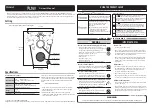
ACM 150
122
During scheduled PM services or following any Service Status messages that might
indicate a pump problem, use the manual tests to check the pumps,
Cycle valve
tests
.
Servicing the venturi pumps
The Bypass Venturi and Gas Cell Venturi are shown in
Figure 11
. There are no
scheduled services for the venturi pumps. If testing indicates inadequate vacuum, try
increasing the CDA pressure. If that does not restore adequate vacuum, run with the
Backup Exhaust Pump and contact HA for service advice.
Servicing the mechanical pumps
The mechanical pumps are shown in
Figure 12
. The Boost Pump has dual heads,
each with a diaphragm and flapper valve that wear out and must be replaced
periodically. The parts and instructions are provided in a service kit (Expendable
Parts List, Section 10.3 ). After removing the old diaphragm and flapper valve, wipe
the internal metal surfaces to remove particles before the new parts are installed.
The Backup Exhaust Pump is intended to operate infrequently. It should never
require service if your venturi pumps operate most of the time. However, if your
facility is unable to provide a supply of CDA sufficient to run the venturi pumps, such
that the Backup Exhaust Pump is in continuous or frequent use, this pump must be
serviced. After it accumulates a total run time of one year, service the pump. Detailed
instructions are provided in
Backup vacuum pump
.
Servicing the valves
Self-Monitoring and Manual Testing
If any solenoid valve fails to switch or open, it will cause a change in absolute
pressure or in the infrared spectrum that is sufficient to generate a Service Status
message in most cases.
During scheduled PM services or following any Service Status messages that might
indicate a sampling problem, use the manual tests to check the valves (
Pneumatic
tests
).
Servicing the sample valves
The Sample Valves are mounted into 10-port manifolds, as shown in
Figure 5
. They
are not expected to wear out and have no replacement schedule. However, a valve
can always fail or develop a problem.
Since the valves mount upside down, there is a possibility that the screws holding
the valves to the manifolds might loosen over time. Also, they have an internal orifice
that controls and balances the bypass flow. If the orifices plug, they will limit the
bypass flow and the response time. The in-line filters stop most particles that can
plug the orifices. Sampling without a filter on any point or drawing in dirty, corrosive
gases increase the possibility of plugging an orifice. Use the manual checks and
tests,
Sample valve tests
, to identify any problems. Follow the service instructions in
Sample valves
.
Servicing the cycle valves
The Cycle Valves are the six solenoid valves installed on a removable plate shown
in
Figure 9
. These valves are activated with far greater frequency than the Sample
Valves. Expect them to wear out eventually. They should be replaced every five
Summary of Contents for ACM 150
Page 1: ...ACM 150 Air Composition Monitor Guide to Installation Operation and Maintenance ...
Page 2: ......
Page 15: ...ACM 150 15 Figure 1 ACM 150 outside labels ...
Page 16: ...ACM 150 16 Figure 2 ACM 150 inside labels ...
Page 29: ...ACM 150 29 Figure 15 Relay output board ...
Page 59: ...ACM 150 59 Figure 30 Installation diagram ...
Page 152: ...ACM 150 152 ...
Page 153: ......
Page 154: ......
Page 155: ......
Page 156: ...ACM 150 Air Composition Monitor Revision 2 ECO HAA150063 December 2015 Honeywell Analytics ...
















































